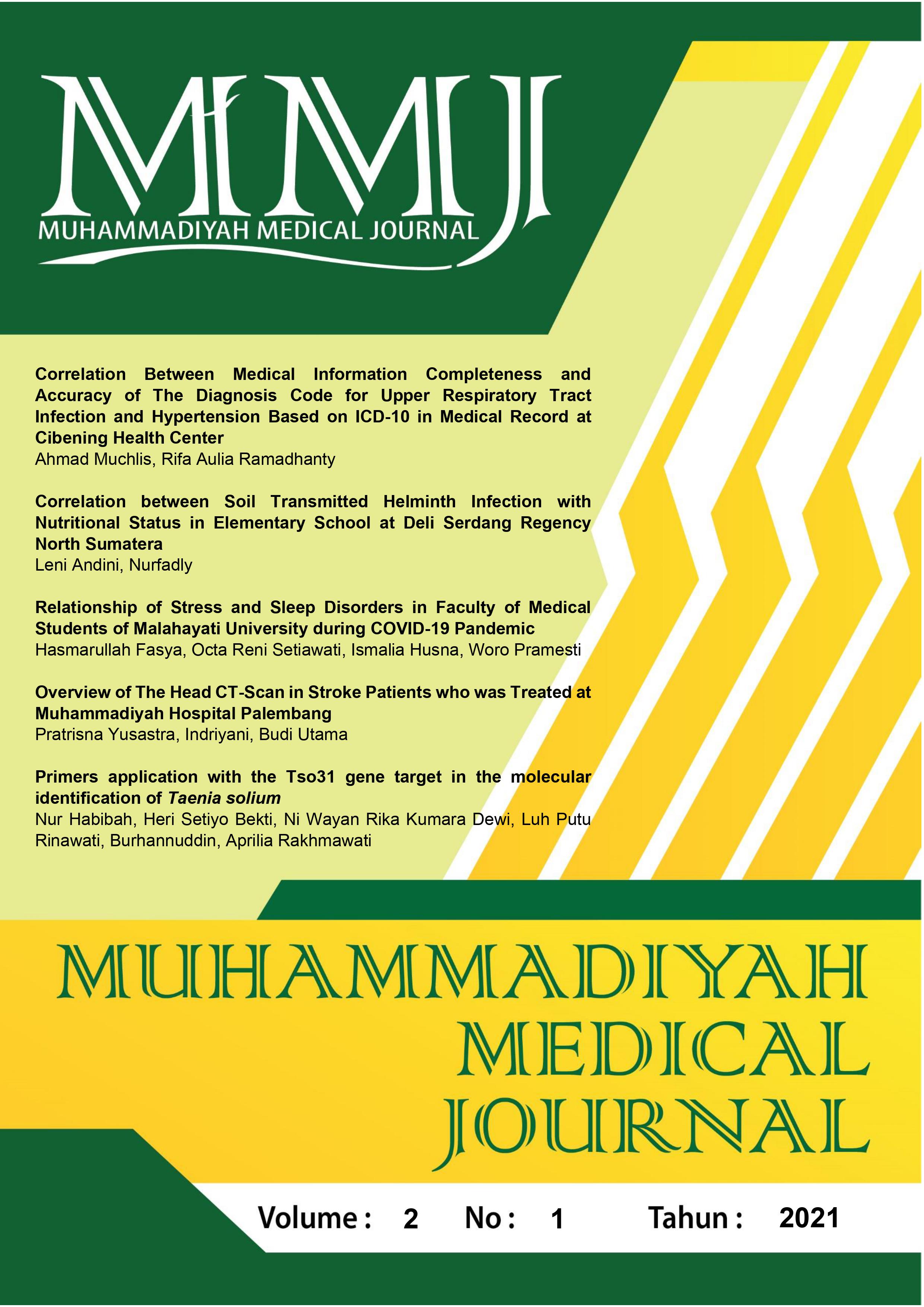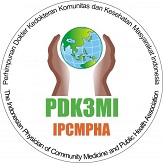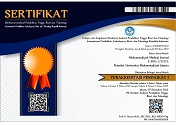Correlation between Soil Transmitted Helminth Infection with Nutritional Status in Elementary School at Deli Serdang Regency North Sumatera
DOI:
https://doi.org/10.24853/mmj.2.1.7-14Keywords:
infection, nutritional status, soil transmitted helminthAbstract
Background: The prevalence of Soil Transmitted Helminth (STH) infections in Indonesia is still high, especially in elementary school children in North Sumatra Province. STH infection is thought to cause harm to nutrient requirements due to lack of calories, causing health and nutritional conditions to decline. Purposes: To determine the relationship of STH infection with nutritional status in 105926 State Elementary School students. Method: Analytic observational with cross sectional design. Sampling uses a total sampling method, with a total sample of 87 people. Nutritional status was determined by the CDC-NCHS 2000 growth curve and the determination of the STH infection used the Kato-Katz examination method. Results: 26 samples (29,9%) were positive and 61 samples (70,1%) were negative for STH infections. Positive samples infected with STH have nutritional status that is dominated by moderate and good nutritional status. Conclusion: There is no correlation between STH infection and nutritional status in 105296 State Elementary School students in Percut Sei Tuan District, Deli Serdang Regency, North Sumatra.References
Hotez PJ, Alvarado M, Basáñez MG, Bolliger I, Bourne R, Boussinesq M, et al. The Global Burden of Disease Study 2010: Interpretation and Implications for the Neglected Tropical Diseases. PLoS Negl Trop Dis. 2014;
Pullan RL, Smith JL, Jasrasaria R, Brooker SJ. Global numbers of infection and disease burden of soil transmitted helminth infections in 2010. Parasites and Vectors. 2014;
Jourdan PM, Lamberton PHL, Fenwick A AD. Soil-transmitted helminth infection. Lancet. 2018;391:252–65.
Bethony J, Brooker S AM. Soil-transmitted helminth infections: ascariasis, trichuriasis, and hookworm. Lancet. 2006;367:1521–32.
Menteri Kesehatan Republik Indonesia. Peraturan Menteri Kesehatan Republik Indonesia Nomor 15 Tahun 2017 Tentang Penanggulangan Cacingan. Jakarta: Menteri Kesehatan Republik Indonesia; 2017.
Dinas Kesehatan Provinsi Sumatera Utara. Laporan Akuntabilitas Kinerja Instansi Pemerintah Dinas Kesehatan Provinsi Sumatera Utara Tahun 2010. Medan; 2011. p. 22–95.
Liu C, Luo R, Yi H, Zhang L, Li S, Bai Y, et al. Soil-transmitted helminths in Southwestern China: A cross-sectional study of links to cognitive ability, nutrition, and school performance among children. PLoS Negl Trop Dis. 2015;
Soedarto. Buku Ajar Parasitologi Kedokteran. Jakarta: Sagung Seto; 2011. 180–204 p.
Kumar S, Singh J, Kumar A. Prevalence and correlation of soil transmitted helminth infection to the degree of anemia and nutritional status among pediatric patients of age group 6-14 years in Kishanganj , Bihar , India. 2017;4(1):83–6.
Samarang Nurjana M SP. Soil transmitted helminth at 10 elementary school in labuan sub district donggala district central Sulawesi. J Heal Epidemiol Commun Dis. 2016;2(2):33–8.
Rosyidah HN PH. Prevalence of intestinal helminthiasis in children at North keputran Surabaya at 2017. J Vocat Heal Stud. 2018;1:117–20.
Darlan DM, Alexandra TS, Tala ZZ. Soil Transmitted Helminth Infections in Medan : a cross- -sectional study of the correlation between the infection and nutritional status among elementary school children. 2017;19(2):98–103.
Fahmida U DD. Handbook nutritional assessment. Jakarta: SEAMEO-TROPMED RCCN, University of Indonesia; 2007.
Daradkeh G, Guizani N MM. Handbook for nutritional assessment through life cycle. New York: Nova Publishers, Inc; 2016.
Kuczmarski RJ, Ogden CL GS. 2000 CDC growth charts for the United States: Methods and development. National Center for Health Statistics. Vital Heal Stat. 2002;11(246).
Renanti R, Rusdji SR, Ematris S. Hubungan infeksi Soil Transmitted Helminth dengan status gizi pada murid Sekolah Dasar Negeri 29 Purus Padang. J Kesehat Andalas. 2015;4(2).
Kamila A. Hubungan Kecacingan Dengan Status Gizi Dan Prestasi Belajar Pada Anak Sekolah Dasar Kelas IV Dan V Di Kelurahan Bandarharjo Semarang. J Nutr Coll. 2018;7(2):77–83.
Fauzi R, Permana O, Fetritura Y. Hubungan kecacingan dengan status gizi siswa sekolah dasar di kecamatan pelayangan jambi. Jambi Med J. 2013;1(2):1–11.
Murni P, Lubis M, Fujiati I. Hubungan infeksi Soil Transmitted Helminth dengan kemampuan kognitif, status nutrisi, dan prestasi belajar pada anak Sekolah Dasar di Desa Sikapas Kabupaten Mandailing Natal. Sari Pediatr. 2018;9(5).
Uneke C, Eze K, Oyibo P, Azu N, Ali E. Soil-Transmitted Helminth Infection In School Children In South-Eastern Nigeria : The Public Health Implication. Journal Third World Med. 2006;4(1):1–7.
Sayasone S, Utzinger J, Akkhavong K, Odermatt P. Acta Tropica Multiparasitism and intensity of helminth infections in relation to symptoms and nutritional status among children : A cross-sectional study in southern Lao People ’ s Democratic Republic. Acta Trop. 2015;141:322–31.
Nurjana MA, Sumolang PPF, Chadijah S, Verdiana NN. Faktor risiko infeksi Ascaris Lumbricoides pada anak Sekolah Dasar di Kota Palu. J Vektor Penyakit. 2013;7(1):23–9.
L Q-C. Prevalence and intensity of interstinal parasitic infections in relation to nutritional status in Mexican school children. J R Soc Trop Med Hyg. 2004;98:653–9.
Worrell CM, Wiegand RE, Davis SM et al. A cross-sectional study of water, sanitation, and hygiene-related risk factors for soil-transmitted helminth infection in urban school and preschool aged children in Kibera, Nairobi. PLoS One. 2016;11(3).
Anderson R, Truscott J HT. The coverage and frequency of mass drug administration required to eliminate persistent transmission of soil-transmitted helminths. Philos Trans R Soc L B Biol Sci. 2014;369(1645):20130435.
Keiser J UJ. Community-wide soil-transmitted helminth treatment is equityeffective. Lancet. 2019;393:3011–2012.
Downloads
Published
Issue
Section
License
Authors who publish in the Muhammadiyah Medical Journal agree to the following terms:
- Authors retain copyright and grant Muhammadiyah Medical Journal right of first publication with the work simultaneously licensed under a Creative Commons Attribution Licence that allows others to adapt (remix, transform, and build) upon the work non-commercially with an acknowledgement of the work's authorship and initial publication in Muhammadiyah Medical Journal.
- Authors are permitted to share (copy and redistribute) the journal's published version of the work non-commercially (e.g., post it to an institutional repository or publish it in a book), with an acknowledgement of its initial publication in Muhammadiyah Medical Journal.








